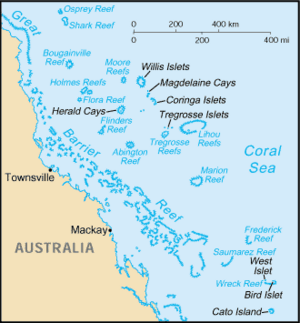Coral Sea Reserves Ramsar Site facts for kids
Quick facts for kids
Designations
|
|
| Official name: Coral Sea Reserves | |
| Designated: | 21 October 2002 |
|---|---|
| Reference #: | 1222 |
The Coral Sea Reserves Ramsar Site is a huge ocean area in the Coral Sea Islands Territory of Australia. It covers about 17,292 square kilometers of islands and coral reefs. This special site includes what used to be the Coringa-Herald National Nature Reserve and the Lihou Reef National Nature Reserve. It's called a "Ramsar Site" because it's recognized internationally as a very important wetland.
Contents
History of the Reserves
People have known about the islands and sandbanks (called cays) in this area since the early 1800s. Many places here are named after the ships and captains who explored them.
How Places Got Their Names
- Lihou Reef was named after Captain John Lihou. He discovered this reef and its cays in 1823 while on his ship, HMS Zenobia.
- The Coringa Islets got their name from a cargo ship called Coringa Packet. This ship sank near Chilcott Islet in 1845.
- The Herald Cays are named after HMS Herald. This ship mapped the Coral Sea from 1849 to 1861.
Becoming Protected Areas
During the 1960s, many scientists visited these islands and reefs. They studied the area and suggested that some parts should be fully protected. Because of their recommendations, the Coringa-Herald and Lihou Reef reserves were officially created on August 16, 1982.
Later, on October 21, 2002, the site was given an even higher level of protection. It was named a "wetland of international importance" under the Ramsar Convention on Wetlands. This means it's recognized globally for its unique natural value.
What Makes This Site Special?
The Coral Sea Reserves Ramsar Site is located on the Coral Sea Plateau. This is about 440 kilometers (273 miles) east of Cairns, a city in Queensland, Australia. It is separated from the Great Barrier Reef by a deep ocean area.
The site is important for many reasons:
- Clean Ocean Life: The marine ecosystems here are almost untouched by humans. They are very clean because they are so far from the mainland.
- Amazing Reefs: It has great examples of rich coral reefs found at the edge of the continental shelf.
- Seabird Haven: Many seabirds, including those that migrate long distances, come here to breed. This makes it a very important place for them.
- Turtle Nesting: It's a safe and important home for green turtles to lay their eggs.
- Rare Forests: You can find Pisonia grandis forests here. These forests are quite rare in Australia and have been destroyed in many other parts of the world.
- Sponge Gardens: The site has a huge variety of marine sponges. In some places, they form beautiful "sponge gardens."
- Unique Fish: The fish and crab-like creatures (called decapod crustaceans) found here are different from those in the Great Barrier Reef.
Animals and Plants
The site has 24 small islands (islets). Many of these have sandy beaches where green turtles can nest without being disturbed. The forests and bushes on the islets are also home to many breeding terns and other seabirds.
Life in the Reefs
The coral reefs themselves support a special community of plants and animals that live on the seafloor. There are also many different kinds of decapod crustaceans and hydroids. The reefs provide feeding grounds for migratory shorebirds and seabirds. Seaweed communities are also very important here.
Land Animals
There are no native land mammals known to live in these reserves. However, black rats were once present on South West Coringa Islet. A program successfully removed them by 1991, which helped protect the native wildlife.
Birds of the Site
Only two types of landbirds breed here: the purple swamphen and the buff-banded rail. But many seabirds call this place home for breeding! Some of the 14 seabird species that breed here include:
- Lesser frigatebird
- Great frigatebird
- Red-footed booby
- Brown booby
- Masked booby
- Black noddy
- Red-tailed tropicbird
Visiting the Reserves
The area has many shipwrecks, which are important for marine archaeology. No people live permanently in the reserves. The main reasons people visit are for nature conservation and scientific research.
The reserves are also famous for diving, snorkeling, and bird watching. Commercial tour groups have limited access, but some private yachts also visit this beautiful area.


